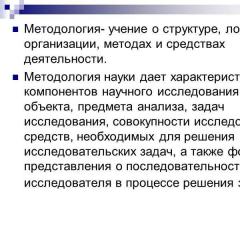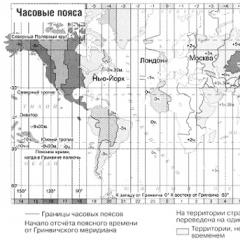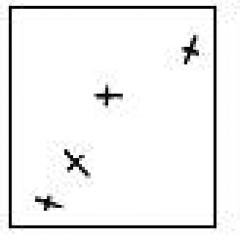Oleg years of life and reign. Prince oleg the prophetic
Reign: 879 - 912
From the biography.
- Prince of Novgorod, from 882-Prince of Kiev.
- He ruled for about 30 years, a relative or vigilante of Rurik (there is no consensus). He was called the Prophetic, i.e. knowing the future, for military luck, intelligence and discernment. He was enterprising, belligerent, decisive, cunning (he seized Kiev by cunning, killing Askold and Dir).
- A tireless warrior, he spent a lot of time on campaigns. After education united state the nature of military campaigns also changed. Oleg began to solve political problems as well: expanding and protecting the borders of the state, strengthening the foreign policy position of Rus.
- Oleg tricked the rulers of Kiev, Askold and Dir, to his boats, and said: “You are not princes and not a princely family, but I am a princely family. And this is the son of Rurik. " After that, he killed Askold and Dir, and made Kiev the capital of Russia, calling it "the mother of Russian cities."
- In 907, Oleg made his first trip to Byzantium. He first used a psychological attack: he put the rooks on their wheels, when the wind blew, they drove towards the city. The Greeks were frightened by this and hastened to make peace. After a successful campaign in 911, a profitable trade agreement was signed with Byzantium, according to which Russian merchants could live in the metropolitan suburb for six months, receive food and even repair their boats at the expense of the Byzantine side, and most importantly, trade duty-free.
- Before Oleg, Slavic tribes paid tribute to the Khazars for two centuries. Oleg was the first to strike them a blow to the Khazar Kaganate, freeing Kiev and a number of other cities and tribes from tribute to the Khazars.
There is a legend that Oleg learned the prediction of the Magi that he would die from his horse. Then he ordered to take the horse away, but ordered to continue to feed and groom him. A few years later, Oleg remembered the horse, but the horse had already died. Then Oleg wanted to say goodbye to him, to look at the bones of the horse. But a snake crawled out of the horse's skull, from the bite of which Oleg died. This episode was described by A.S. Pushkin in the famous work, which is called "The Song of the Prophetic Oleg."
Pictures by V.M. Vasnetsova: 

V.M. Vasnetsov, 1899
Historical portrait of Oleg the Prophet: areas of activity
1. Domestic policy of Oleg the Prophet
| Activities. | Results. |
| 1. Strengthening the position of the prince. | Imposed a tribute on the tribes. Polyudye. He established general taxes throughout the entire territory, put his mayors in cities, took the title of Grand Duke, and all the rest were his tributaries. |
| 2. Formation of a unified state. | 882-formation of the state, Kiev-capital ( "Mother Russian cities". Consolidation of two centers - Kiev and Novgorod. The unification of the eastern tribes. Subdued the tribes of the Slavs, Krivichi (Smolensk), Drevlyans in 883, Radimichi in 885, Northerners in 883 (Lyubech), subdued the Vyatichi, Croats, Dulebs, Tivertsy, and ulcers. |
| 3. Protection of Kiev - the capital of Russia. | New fortifications were built around the city. |
| 4. Ensuring the security of the state. | Builds outlying cities. " Start building cities. " |
2. Foreign policy of Oleg the Prophet
The results of the activities of Oleg the Prophet:
1.the formation of the state - in 882. The first ruler of Russia, who united the Slavic tribes along the path "from the Varangians to the Greeks."
3.acceptance of the title of Grand Duke, all other princes are his tributaries, vassals.
4. creation of favorable conditions for the development of agriculture, crafts, foreign trade, the formation of a social structure, the development of ancient Russian culture.
5. Strengthening the foreign policy position of Russia.
The importance of Prince Oleg in the history of Russia is enormous... He is remembered and honored as the founder of the state, who strengthened it, and also consolidated its power, raised the international authority of Russia. However, unfortunately, there was no place for Prince Oleg the Prophet on the pedestal of Mikeshin's "Millennium of Rus" monument in 1862.
Chronology of the life and work of Oleg the Prophet
Oleg the Prophet in literature:
A.S. Pushkin. "Song of the Prophetic Oleg."
B. Vasiliev. "Prophetic Oleg" 1996
N.P. Pavlishchev. "Prophetic Oleg." 2008
TERMS
Anti-Norman theory(M. Lomonosov, B.A. Rybakov), according to which the state was formed in 882.
Borticulture- collection of wild honey.
Grand Duke- the head of the great principality in Russia in the 10-15th century, the Russian state in the 15th-middle of the 16th century.
Veche- People's Assembly in Russia in the 10-14 centuries. It resolved issues of war and peace, summoned and expelled princes, passed laws, concluded treaties with other states.
Byzantium- a state that arose in the 4th century in the eastern part of the Eastern Empire as a result of its collapse. It existed until the 15th century, the capital is Constantinople, in Russia it was called Constantinople. V 1453 captured Byzantium Ottoman Empire, the capital was renamed to Istanbul.
Military democracy- a social structure in which the military nobility stands out (the prince and the squad), concentrating in their hands significant material values and political power.
Ancient Russia- the first name of the state in the 11-13th centuries.
Druzhina–Armed detachments under the prince, who participated in wars, management of the principality and the prince's personal economy.
Smoke - unit of taxation from the yard.
Procurement- peasants who took a loan from landowners ("kupu"), livestock, grain, tools of labor and were forced to work off the debt.
Prince- at first it was the leader of the tribe, the head of the squad. With the development of feudal society - the head of the principality. The eldest were called great, the rest were called appanages.
Chronicle- historical chronicles in the 11-18 centuries. Event recording by year.
Rent- an annual collection of tribute - money, food, handicrafts - from the peasants.
Rope-world- community.
Transfer agriculture- a method of cultivating the land, in which shrubs were cut down and burned, the fertilizer was used for 5-7 years.
Slash and burn agriculture- forests were uprooted, burned. This fertilization lasted up to 15-3-20 years.
Polyudye- a detour by the prince with a squad of all his lands to collect tribute.
The path "from the Varangians to the Greeks"- a waterway connecting Northern Russia with the South. It went from the Varangian (Baltic) Sea along the Neva, Ladoga Lake, Volkhov River, Ilmensky Lake, Lovat River, then dragged to the Dnieper River, along it to the Black Sea, then along the sea coast to Byzantium.
Early feudal monarchy- the state of the transitional period from the primitive communal system to the feudal one. In the 8-11 centuries. the process of the formation of feudal relations took place in Russia while preserving the elements of the primitive communal system (veche, blood feud, paganism, tribal customs).
Ryadovichi- smerds (peasants) who entered into an agreement (row) with landowners on the conditions of work for him or the use of his land or tools.
Smerds- free communal peasants who had their own farm and arable land.
Lot- the share of a member of the princely family in the ancestral possession.
Feudalism- the stage of human development, which replaced the primitive communal system. Under feudalism, the land belongs to the feudal lords - large landowners ("feud" - land), who passed on rights by inheritance. The peasants had their own economy, family, fed themselves, bore obligations. The feudal lord appropriated the labor of the peasants in the form of feudal rent.
Feudal rent- payment for the use of land by feudal lords in the form of labor (corvee), natural food quitrent or monetary quitrent.
Khazars- nomads, Turkic-speaking people. State - Khazar Kaganate, capital - Itil. They were finally defeated by Svyatoslav in 965.
Slaves- a feudal-dependent population, by legal status close to slaves. Sources of the formation of this class: captivity, sale for debts, marriage with a slave or servant, etc.
Centrist theory- the state of Rus was formed as a result of internal common Slavic development, but with the participation of the Varangians (A.L. Yurganov, L.A. Kovtsa and most modern historians).
Servants- in the 9-12 centuries - slaves, later - a wide circle of feudal-dependent people.
The reign of Prince Oleg (briefly)
The reign of Prince Oleg - a short description
Chronology of the reign of Prince Oleg 882-912
In 879, after the death of Rurik, his relative Oleg became the prince of Novgorod (this happened due to the early childhood of Igor, the son of Rurik). The new prince was very belligerent and adventurous. As soon as he ascended the princely throne, he set a goal to seize the waterway to Greece. However, for this it was necessary to conquer all the Slavic tribes living along the course of the Dnieper.
Since in order to achieve the set goals of one squad was not enough, Oleg gathers an army from the Finnish tribes, as well as the Krivichi and Ilmen Slavs, after which he moves to the south. On his way, he subdues Smolensk, Lyubech (there he leaves some of the soldiers), and then goes to Kiev.
At that time, Askold and Dir, who did not belong to the princely family, ruled in Kiev. Oleg lured them out of the city by cunning and gave the order to kill them. After that, the people of Kiev surrendered without a fight, Oleg took the place of the great Kiev prince, and the city itself proclaimed "the mother of Russian cities."
The new Kiev prince carried out large-scale work to strengthen the city's structures, which were responsible for its defense, and also conducted several successful military campaigns in 883-885, thereby expanding the lands subject to Kiev. In addition, Oleg subdued the Radimichs, the Northerners and the Drevlyans. In the conquered lands, he erected fortresses and cities.
Domestic policy during the reign of Prince Oleg
Domestic policy under Oleg was reduced to collecting tribute from the conquered tribes (in fact, it remained the same as under other rulers). The tribute was fixed throughout the state territory.
Foreign policy during the reign of Prince Oleg
The year 907 was marked for Prince Oleg and Rus by a very successful campaign against Byzantium. Frightened by a huge army and falling for Oleg's trick (the ships were put on wheels and walked on land), the Greeks offered the prince of Kiev a huge tribute, which he accepted on the condition that Byzantium would provide Russian merchants with benefits. Five years later, Oleg signed a peace treaty with the Greeks.
After this campaign, they began to make up legends about the prince, attributing to him supernatural abilities and possession of magic. From the same time, the people of Prince Oleg began to be called the Prophetic.
The prince died in 912... According to the legend, Oleg once asked the sorcerer the reason for his death, and he answered him that the prince would die from his faithful beloved horse. After that, Oleg gave the horse to the stable, where he was looked after to death. Having learned about the death of the horse, the prince came to his bones on the mountain to say goodbye to true friend, where he was bitten in the leg by a snake that crawled out of the horse's skull.

Prophetic Oleg - the great Russian prince, who finally united the Slavic tribes.
Almost nothing is known about the origin of Oleg. There are only a few theories based on the annals. It is generally accepted that he was not part of the Rurik dynasty. Nevertheless, he played an important role in politics and was close to Rurik. The latter trusted Oleg so much that he made him the regent of his son Igor. After the death of the first prince in 879, Oleg received power, which he could dispose of only until Igor grew up. After receiving the title of prince, he immediately set himself the goal of expanding the influence of Russia.
He began by capturing the territories adjacent to the Dnieper River. He gathered a huge squad, which consisted of the most diverse peoples, and moved south. He met colossal resistance from local tribes. But the princely soldiers were strong, so all opponents were defeated. Now they had to pay a fairly large tribute. He could capture the richest city of Kiev with the help of cunning and dexterity. He did not suddenly attack him. Instead, Oleg decided to pretend to be an overseas merchant. The prince swam to the coast of Kiev on the same boat. The rulers of the city came out to him - princes Askold and Dir, who did not even suspect about the ambush. When they approached a sufficient condition, Oleg's warriors suddenly jumped out of their ships, surrounding the gullible princes. They were killed, and Oleg became By the Kiev prince... But he did not stop there. Later, he forced to pay tribute to the Drevlyans and the northerners. The prince's authority increased.
The turning point in his life was the campaign against Byzantium. At that time, he had a large army. If Byzantium paid tribute, then Russia would receive colossal income. Took place Great trek to Constantinople, which ended in success. His warriors were distinguished by increased cruelty and aggression. All those who opposed them instantly died from the blows of swords and spears. Russian troops plundered small towns and villages. In this regard, the Byzantine government had to make concessions. Oleg demanded 12 pounds of silver, valuable at that time. During the negotiations, the conditions became softer, but the scale of the losses of the Byzantines still remained enormous. In addition, now Russian merchants could trade freely here, they were also endowed with privileges and benefits.
The campaign brought the prince incredible fame, legends began to circulate about him, praising his exploits during the siege of Constantinople. There were stories about the shields nailed by Oleg to the wall of the capital of Byzantium. Per unique abilities the ruler of Russia was named "Prophetic". Oleg died under mysterious circumstances in 912. There is a theory that he was poisoned by the poison of a snake that bit him while he was visiting the grave of his horse.
Biography 2
Prince Oleg went down in history as a rather enterprising and warlike ruler. The period of his reign was accompanied by the rapid growth of the military and political influence of Kievan Rus.
The origin of Prince Oleg
According to The Tale of Bygone Years, Oleg was a relative of Rurik. Some researchers believe that Oleg was the brother of Rurik's wife. It is indisputable that Oleg was a Scandinavian. In the epic of the peoples of Scandinavia, there are legends that describe a certain prince named Helge, who performed many feats and ruled over the peoples of the Slavs. Most likely, this Helge is Prince Oleg.
The beginning of the reign
In 879, an event occurs that radically changes Oleg's life. The dying prince Rurik delegates to him the right to occupy the Novgorod throne.
As soon as the power was in his hands, Oleg immediately began to crush the Dnieper under his influence along the entire course. Of course, such an event required a huge number of soldiers, thanks to political persuasion, and in some situations and by force, the prince recruited a large army. Then he began his march to the south. During his first campaign, Prince Oleg captured: Smolensk, Lyubech and set his sights on the capture of Kiev.
According to The Tale of Bygone Years, in 882, Oleg began military campaign to capture Kiev. However, the princes Askold and Dir were the legitimate rulers of the city, but Oleg quickly resolved this problem. Princes Askold and Dir were killed.
In subsequent years, the prince rather thoroughly dealt with the ordering of the captured lands, a centralized vertical of power was created.
The reign of Prince Oleg after the capture of Kiev
In 907, Oleg began a large military company against Byzantium. The Greeks were afraid of the military might of the Slavs and bought off Oleg. According to legend, Oleg nailed his shield to the gates of the city.
In 911, Oleg sent an embassy to Byzantium and concluded a lasting trade agreement. Although already the treaty from this year does not bring the Slavs such significant privileges in trade, which partly indicates the increased military power of Byzantium.
According to The Tale of Bygone Years, the prince died from a snake bite, which was hiding in the remains of a horse. The chronicle itself dates this event to 912.


